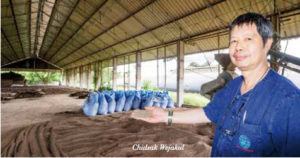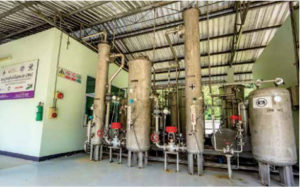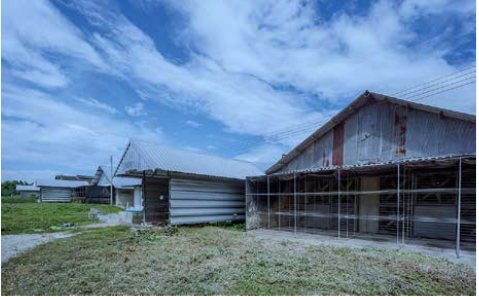Take good care of the environment is as important as having a well-run operation, according to Chidsak Wejakul, managing director Ruam Porn Mitr Farm Co Ltd.
Ruam Porn Mitr (RPM) decided to install a biogas system in 1996 to reduce manure odours and flies which could potentially upset nearby communities.

Chidsak Wejakul
Due to rapid road network development and the arrival of better electricity infrastructure, the formerly remotely located RPM farm is now surrounded by growing communities. Without good environmental management, public sentiment could shut down his business.
The company decided to go ahead with biogas to prevent potential conflicts. The biogas produced by fermenting manure is used to generate electricity for use on the farm and the excess gas is supplied to nearby households.
The Energy Research and Development Institute (ERDI) at Chiang Mai University helped design the system. At that time, layer biogas was in its infancy. Previously, ERDI had consulted mainly with swine producers.
Investment in the biogas system was substantial, but the project was partially subsidized by the Energy Policy and Planning Office of Thailand’s Ministry of Energy.
Manure is removed from the layer house everyday via conveyor and then dropped down a chute where it is flushed to a preparation pool and mixed with water. Foreign materials such as sand, stones and feathers are filtered out before the slurry is fed into the anaerobic digestor.
It opted for an Up-Flow Anaerobic Sludge Blanket system with a five-day retention time. The system has two channel digestors, one with 1,000 cubic metres of manure capacity and the other 2,000 cu m. The system can handle the manure produced by 120,000 birds.
Discharged effluent from the digestors is released and treated in various ponds. Treated water is used for gardening. Chemical oxygen demand (COD) – a measure of water quality and waste-water treatment efficiency — after the final treatment is below 300-400 mg/litre, on par with Thailand’s Pollution Control Department regulations.
The methane is used for ring a 150 KW gen set, with savings on the farm’s electricity bill averaging around 100,000 baht/month. Gas for cooking fuel is su plied to farm staff as well as more than 150 households nearby via a pipeline on the condition that the gas should not be used for commercial purposes.

Compressed biogas distribution station supplies 384 kg of cbg/day to users in the nearby area
The pipeline distribution system meets American National Standard ASME, B31 specifications.
Users pay 100 baht/month for system maintenance, and half of all fees are returned to the community.
The processed manure, estimated at 36 tonnes/month, is sold as fertilizer to horticultural producers and rice farmers.
Biogas from anaerobic organic waste digestors usually contains 60-70% methane, 30-40% carbon dioxide and <1% nitrogen and hydrogen sulfide. Therefore, it needs to undergo water scrubbing where CO2, H2S and CH4 levels are reduced to match the specs of compressed natural gas (CNG) from non-renewable sources.
The processed biogas quality is on par with Thailand’s Department of Energy Business guidelines where CBG is 83-89% by volume, Wobbe Index = 37-42 MJ/Nm3, sulphur below 50 mg/m3.
The biogas is compressed to 200 bar for distribution via the gas pipeline network.
Mr Chidsak added that the quality of the methane is clean enough to sell for use in automobiles, but obtaining the necessary licences would be cost-prohibitive.
In addition to its layer business, the company also operates a PS farm supplying pullets. It produces around 4,000 tonnes/ month of feed for internal use and for customers.
The company is planning to convert its pullet farm from floor-reared to battery cages. Each house will contain four rows and four tiers holding around 30,000- 33,000 birds in total.
Given the growing nearby community and the rising price of farm land, RPM is considering the pros and cons of modifying the farm to boost layer and biogas capacity.
“The land in San Pa Tong is far too expensive. We need to optimize land use and maintain a good rapport with the community,” he said.
Production and marketing
RPM has a breeder operation and a state- of-the art hatchery with weekly capacity of around 30,000 day-old chicks which are used internally.
The company sells more than 500,000 eggs/day to customers within a 250-km radius around Chiang Mai. The customers are primarily located in the upper north in Chiang Rai, Lam Pang, Mae Hong Son and Tak.
In parallel with traditional wet markets, it has developed new distribution channels via modern trade, hypermarts, food service outlets and bakeries.
Consumer preference for modern trade retailers is growing by leaps and bounds, while wet markets are mainly stagnant, he said.
Egg quality testing is done on an occasional basis. The eggs produced from RPM’s own farm and its alliances target a yolk colour of at least 11 on the colour fan and haugh unit above 83%.
The company plans to convert all of its pullet rearing capacity over to caged systems before the end of 2018 in order to improve the quality and uniformity of its pullets.

